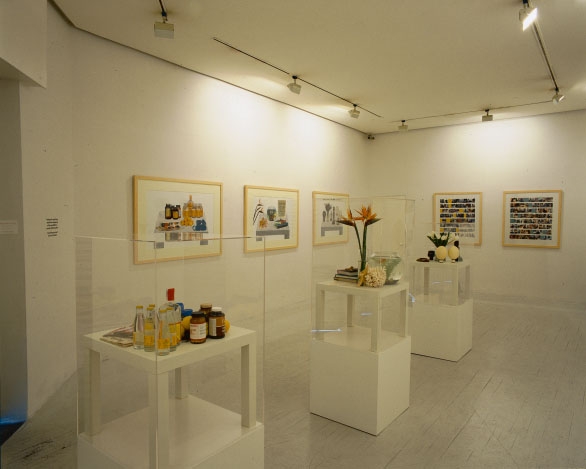Naturalezas Muertas
13 February – 25 March 1998
Galeria Oliva Arauna, Madrid
– “Spanish Family of Ikea – U.S. Family of Ikea,” 1998, laserchrome; each 42 x 38 inches; collection of the artist
– “The Party Girls,” 1998, iris print, edition of 3; 40 x 56 inches
– “The Entertainer,” 1998, iris print, edition of 3; 40 x 56 inches
– “The Collector,” 1998, iris print, edition of 3; 40 x 56 inches
– “What You Can’t See Is How Well It Goes with Your Student Loans,” 1998, props on a base, Plexiglas, Ikea Lack table; 59 x 23 x 23 inches
– “You’ll Probably Never Need It,” 1998, props on a base, Plexiglas, Ikea Lack table; 68 x 23 x 23 inches; Themistocles and Dare Michos, San Francisco
– “Wenn Ansprüche wachsen,” 1998, props on a base, Plexiglas, Ikea Lack table; 59 x 23 x 23 inches
Courtesy of Galeria Oliva Arauna, Madrid
In his gallery exhibition in Madrid, Christian Philipp Müller showed three sculptural still lifes, two group portraits, and three digital collages with motifs taken from catalogues of the Swedish furniture company IKEA.
IKEA was founded in Sweden in 1943; today, it sells over 10,000 products in 35 countries. At the time of the exhibition, 39 different editions of the catalogue were available in 17 languages. IKEA had just appeared on the Spanish market and was attempting to gain a foothold as an upper-middle-class brand. In “Naturalezas Muertas,” Müller compared the Spanish, German, and American editions of the catalogue and, in his re-stagings of the lifestyle promoted there, explored the characterizations and stereotypical variations used to present an identical palette of products.
In the diptych “U.S. Family of IKEA – Spanish Family of IKEA,” Müller isolated the persons illustrated in both versions of the catalogue and combined them into family portraits. Here, people of all age groups with the ethnicities assigned to them in the catalogue were combined into large-scale group portraits of their own national IKEA world. While the American version showed multicultural families, the Spanish world of IKEA was populated by blond people. In the sculptural still lifes, Müller explored the staged lifestyles of the IKEA family and extracted from them three groups of objects. He copied the combination of decorating accessories suggested in the catalogue, taking all the objects illustrated on a double-page spread that were not sold through IKEA. He then arranged them on “LACK” (the white IKEA coffee table), giving them an even more museum-like appearance by placing them on pedestals under Plexiglas covers.
The three framed wall pieces further explored the typology of targeted consumer groups. The digital collages “The Collector,” “The Entertainer,” and “The Party Girls” repeated the presentation of IKEA lifestyles in two-dimensional form. Isolated from their catalogue setting, the objects lost their apparent individuality, making them highly interchangeable.


